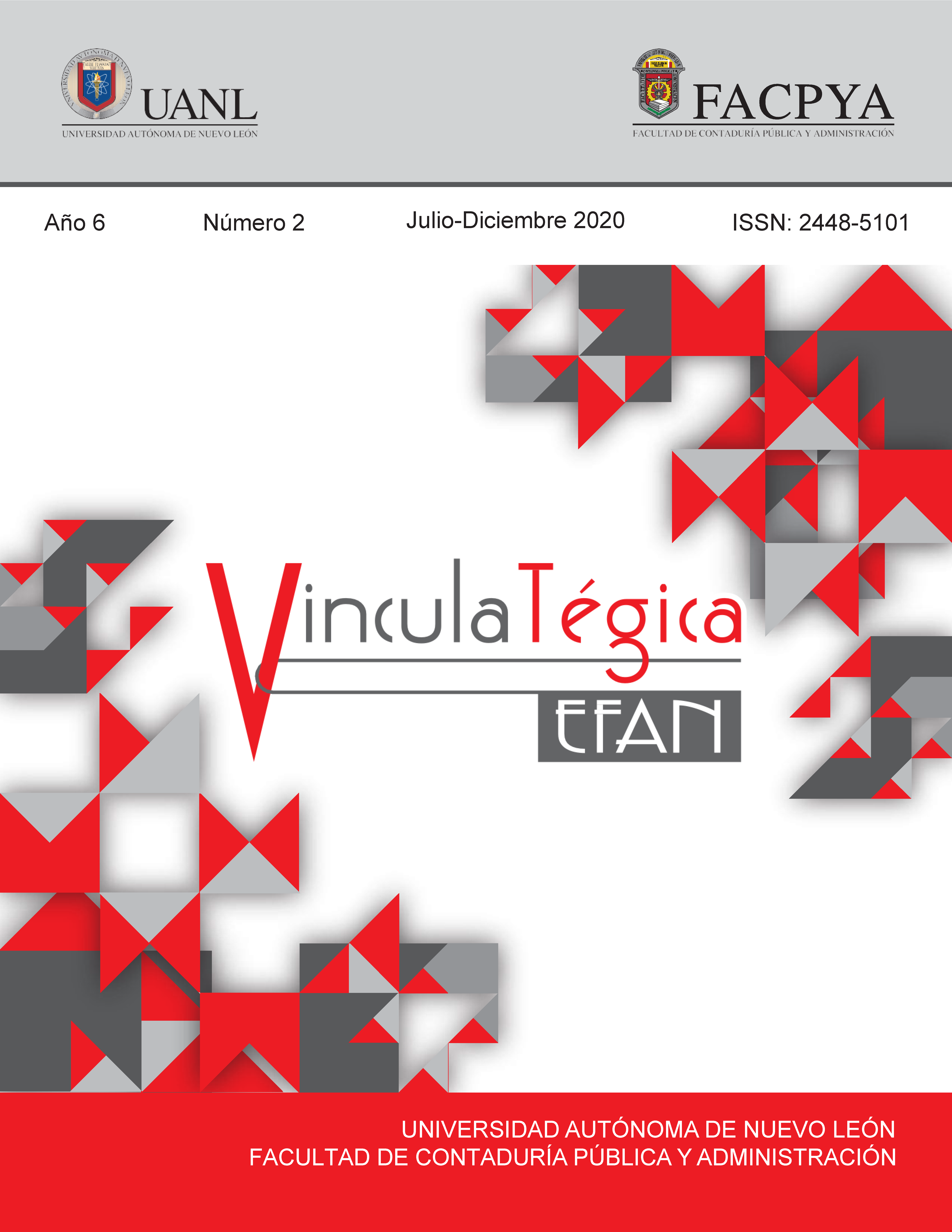El clima laboral como elemento de gestión en crisis laboral
DOI:
https://doi.org/10.29105/vtga6.2-676Keywords:
clima laboral, gestión, crisis laboral, talento, recursos humanosAbstract
The aim of the research work, non-experimental, longitudinal and descriptive scope, mixed approach was to analyze the perception of staff by measuring the work environment in an engineering company after the efforts made by a labor crisis. The measurement was based according to the model Marvin Weisbord and a questionnaire considering the respective factors and issues. A perception index per year, a minimum level of acceptance, as well as strengths and weaknesses in aspects of organizational development were identified. It was concluded that the working environment shows increasing favorably, and positive impact on your index measurement. Also, the strengths and weaknesses in general, department and type of staff (administrative and sindicalizado personal) were identified.
Downloads
References
Chiavenato. (2009). Gestión del Talento Humano (Tercera ed.). (P. M. Sacristán, Trad.) México, México: McGraw Hill Educación.
Hernández Sampieri, R., Fernández Collado, C., & Baptista Lucio, M. D. (2010). Metodología de la Investigación (Quinta ed.). México: McGraw Hill.
Prado, J. F. (2015). Clima y ambiente organizacional: Trabajo, salud y factores psicosociales. (L. S. Fuentes, Ed.) México, México: El Manual Moderno.
Robbins, Stephen P. (2004). Comportamiento Organizacional (10 ed.). (E. Q. Duarte, Trad.) México, México: Pearson Educación.
Aguirre, L. R., Campos, Á. F., & Méndez, A. G. (2013). EL CLIMA LABORAL COMO UN ELEMENTO DEL COMPROMISO ORGANIZACIONAL. RNA, 4(1), 59-70. Recuperado de https://dialnet.unirioja.es/servlet/articulo?codigo=4721419 DOI: https://doi.org/10.22458/rna.v4i1.533
Bordas, María de Jesús. (2016). Gestión estratégica del clima laboral. Madrid, España: UNED. Obtenido de www.uned.es/Publicaciones
Calle, A. (3 de diciembre de 2018). Grupo PowerData. (Centro de Recursos) Obtenido de PowerData: https://focushumanconsulting.com/2018/12/03/big-data-que-es-y-como-usarlo-en-rrhh/
Ezquiaga, G. (2011). El clima organizacional o clima laboral, una prioridad de la empresa. Recuperado de http://trabajarmejor.com.ar/sitio/articulo.php?id=clima_organizacional_clima_laboral_prioridad _empresa
Gómez J.(2). (17 de noviembre de 2016). cerem. Obtenido de International Business School: www.cerem.es/blog/se-buscan-perfiles-analiticos-para-la-gestion-del-big-data-aplicado-a-losrrhh
Gómez J.(1). (17 de noviembre de 2016). cerem. Obtenido de International Business School: www.cerem.es/blog/se-buscan-perfiles-analiticos-para-la-gestion-del-big-data-aplicado-a-losrrhh
Marroquín, W. E., García, H. E., Manotoa, H. P., & Vieira, J. F. (2019). La responsabilidad social corporativa y el clima laboral. Recuperado de http://cienciadigital.org/revistacienciadigital2/index.php/visionariodigital/article/view/974
Marvin, W. (4 de diciembre de 1976). SIX BOX MODEL. Obtenido de Welcome to Marvin Weisbord.com: www.marvinweisbord.com/index.php/six-box-model/
Mogollón, H. M. (2000). EL DESARROLLO ORGANIZACIONAL COMO FACILITADOR DEL CAMBIO. Estudios Gerenciales(77), 13-26. Recuperado de https://icesi.edu.co/revistas/index.php/estudios_gerenciales/article/view/229/html
Orellana, B. J., & Portalanza, C. A. (2014). Influencia del liderazgo sobre el clima organizacional. Suma de Negocios, 5(11), 117-125. Recuperado de https://elsevier.es/es-revista-suma-negocios208-articulo-influencia-del-liderazgo-sobre-el-s2215910x14700266 DOI: https://doi.org/10.1016/S2215-910X(14)70026-6
Patlán-Pérez, J., Torres, E. M., & Hernández, R. H. (2012). El Clima y la Justicia Organizacional y su Efecto en la Satisfaccion Laboral (The Impact of Organizational Climate, Organizational Justice on Job Satisfaction). Recuperado de https://papers.ssrn.com/sol3/papers.cfm?abstract_id=2094718
Pérez de Maldonado, I. &. (2006). Clima organizacional y gerencia: inductores del cambio organizacional. Investigación y Postgrado, 21(2), 231-248. Obtenido de https://www.redalyc.org/articulo.oa?
Santillán Marroquín, W. E., Paredes García, H. E., Bermeo Castillo, C. A., & Mera Manotoa, H. P. (20 de noviembre de 2019). www.visionariodigital.org. doi:https://doi.org/10.33262/visionariodigital.v3i4.984 DOI: https://doi.org/10.33262/visionariodigital.v3i4.984
Schneider, B. E. (ene de 2013). ANNUAL REVIEWS. Obtenido de https://doi.org/10.1146/annurevpsych-113011-143809
Torres, A. S., & T, E. A. (2002). Calidad de vida laboral: hacia un enfoque integrador desde la psicología social. Psicothema, 14(4), 828-836. Recuperado de http://psicothema.com/pdf/806.pdf
Zapata, J. P., & Ramírez, J. A. (2007). Barreras para el aprendizaje organizacional Estudio de casos. Recuperado de http://rcientificas.uninorte.edu.co/index.php/pensamiento/article/view/3540/2265
Zenteno-Hidalgo, Á., & Durán Silva, C. (8 de enero de 2016). Factores y prácticas de alto desempeño que influyen en el clima laboral: Análisis de un caso. 26(59), 98. (Innovar, Ed., & b. P. UN, Recopilador) Chile. Recuperado de https://doi.org/10.15446/innovar.v26n59.54367 DOI: https://doi.org/10.15446/innovar.v26n59.54367
Downloads
Published
How to Cite
Issue
Section
License

This work is licensed under a Creative Commons Attribution 4.0 International License.
a). Authors keep copyright and give the journal the right of the first publication of the work under a Creative Commons attribution license. This license allows others to share the work as long as original authorship and initial publication in this journal is acknowledged.
b). Authors may make other independent and additional contractual agreements for the non-exclusive distribution of the version of the article published in this journal (e.g., include it in an institutional repository or publish it in a book) as long as they clearly indicate that the work was published for the first time in this journal.







